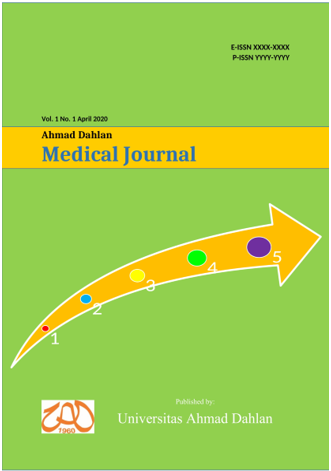Comparative Study on TGF-β Expression of Large Continues and Small Continues Stitch Technique Using Polyglecaprone 25 on Abdominal Skin Incision in Rattus Novergicus
DOI:
https://doi.org/10.12928/admj.v2i1.3914Keywords:
polyglecaprone 25, large stitch, small stitch, transforming growth factor beta, abdominal skin closure.Abstract
Ideal closing of the abdominal wound will provide strength and prevent infection. Abdominal wall closure method is an important aspect of effective incision closure, besides the choice of suture material. TGF-β generally involved in wound healing process. The suture technique is also important in wound healing process. This study aims to compare the large stitch technique with the small stitch technique for abdominal skin closure. Twenty rats were used in 4 groups. The small stitch group received small tissue bites of 5 mm from wound edge, and the large tissue group received large bites of 10 mm from wound edge. The incision of the skin was closed by running suture using polyglecarprone 25. Animal model were euthanized on the 4th and 7th day post incision. Tissue section were examined using immunohistochemistry method to measure TGF-β expression. The results were analyzed using t-test and the effect size. Rats in the small stitch group had higher TGF-β expression on day 4th and 7th than those in the large stitch group. TGF-β expressions in the small stitch group were 0,87 -fold greater on day 7th than day 4th and were 0,71 -fold greater in the large stitch group (p = 0,410). The significance analysis on day 4th with a result of 0,082 and day 7th with a result of 1.48, which means day 7th showed high effect (Cohen's d> 0.8) on wound healing than day 4th. In conclusion, polyglecaprone 25 use as a suture material on the day 7th showed a high effect in terms of TGF- β expression.
References
Dart, A. J. et al. (2011) ‘Suture Material: Conventional and Stimuli Responsive’, Comprehensive Biomaterials, pp. 573–587. doi: 10.1016/B978-0-08-055294-1.00245-2.
Fortelny, R. H. et al. (2015) ‘Effect of suture technique on the occurrence of incisional hernia after elective midline abdominal wall closure: Study protocol for a randomized controlled trial’, Trials, 16(1), pp. 1–8. doi: 10.1186/s13063-015-0572-x.
Prima, H. et al. (2020) ‘The impact of different suturing techniques for abdominal fascia closure on the Interleukin-6 expressions in Rattus norvegicus’, BMC Research Notes, 13(1), p. 502. doi: 10.1186/s13104-020-05349-y.
Kenig, J, et al. (2013) 'Risk factors for wound dehiscence after laparotomy-Clinical control trial'. Pol Przegl Chir. ;84(11):565-73. doi: 10.2478/v10035-012-0094-0.
Kopf, M. et al. (1994) ‘Impaired immune and acute-phase responses in interleukin-6-deficient mice’, Nature, 368(6469), pp. 339–342. doi: 10.1038/368339a0.
Lin, Z.-Q. et al. (2003) ‘Essential involvement of IL-6 in the skin wound-healing process as evidenced by delayed wound healing in IL-6-deficient mice’, Journal of Leukocyte Biology, 73(6), pp. 713–721. doi: 10.1189/jlb.0802397.
Marston WA (2006), 'Dermagraft Diabetic Foot Ulcer Study Group. Risk factors associated with healing chronic diabetic foot ulcers: the importance of hyperglycemia'. Ostomy/wound Management. Mar;52(3):26-8, 30, 32 passim.
Harlaar, J. J. et al. (2010) ‘Effect of stitch length on wound complications After Closure of Midline Incisions A Randomized Controlled Trial’, Archives of Surgery, 145(6), p. 599. doi: 10.1001/archsurg.2010.78.
Sajid, M et al., (2014) 'Systematic review of absorbable vs non-absorbable sutures used for the closure of surgical incisions'. World J Gastrointest Surg.; 6(12): 241–247. doi: 10.4240/wjgs.v6.i12.241
Smeltzer, S.C., & Bare, B.G. (2010) 'Post operative nursing wound management'. In Brunner & Suddart's Textbook of medicalsurgical nursing (12th ed.). Philadelphia: J.B. Lippincott Company.
Spiliotis, J., T siveriotis, K., Datsis, A.D.,Vaxevanidou, A., Zacharis, G., Konstantinos, G. Rogdakis, A. (2009) 'Wound Dehiscence : is still a problem in the 21th century : a restropective study'. World Journal of Emergency Surgery, 4(12), 1–5. doi:10.1186/1749-7922-4-12.
Van Ramshorst, G. H. et al. (2012) ‘Impact of incisional hernia on health-related quality of life and body image: A prospective cohort study’, American Journal of Surgery. doi: 10.1016/j.amjsurg.2012.01.012.
Downloads
Published
How to Cite
Issue
Section
License
Copyright (c) 2021 Dhyas Munandar AS

This work is licensed under a Creative Commons Attribution-ShareAlike 4.0 International License.
License and Copyright Agreement
In submitting the manuscript to the journal, the authors certify that:
- They are authorized by their co-authors to enter into these arrangements.
- The work described has not been formally published before, except in the form of an abstract or as part of a published lecture, review, thesis, or overlay journal. Please also carefully read Ahmad Dahlan Medical Journal posting Your Article Policy.
- That it is not under consideration for publication elsewhere.
- That its publication has been approved by all the author(s) and by the responsible authorities - tacitly or explicitly - of the institutes where the work has been carried out.
- They secure the right to reproduce any material that has already been published or copyrighted elsewhere.
- They agree to the following license and copyright agreement.
Copyright
Authors who publish with Ahmad Dahlan Medical Journal agree to the following terms:
- Authors retain copyright and grant the journal right of first publication with the work simultaneously licensed under a Creative Commons Attribution License (CC BY-SA 4.0) that allows others to share the work with an acknowledgment of the work's authorship and initial publication in this journal.
- Authors are able to enter into separate, additional contractual arrangements for the non-exclusive distribution of the journal's published version of the work (e.g., post it to an institutional repository or publish it in a book), with an acknowledgment of its initial publication in this journal.
- Authors are permitted and encouraged to post their work online (e.g., in institutional repositories or on their website) prior to and during the submission process, as it can lead to productive exchanges, as well as earlier and greater citation of published work.


